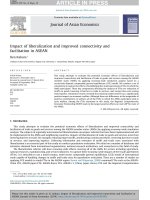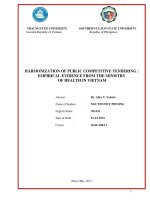hanbook of health economics volume 1a
Bạn đang xem bản rút gọn của tài liệu. Xem và tải ngay bản đầy đủ của tài liệu tại đây (8.27 MB, 1,000 trang )
HANDBOOK OF HEALTH ECONOMICS
VOLUME 1A
This Page Intentionally Left Blank
HANDBOOK OF
HEALTH ECONOMICS
VOLUME 1A
Edited by
ANTHONY J. CULYER
University of York
and
JOSEPH P. NEWHOUSE
Harvard University Medical School
2000
ELSEVIER
AMSTERDAM • LAUSANNE • NEW YORK • OXFORD • SHANNON • SINGAPORE • TOKYO
ELSEVIER SCIENCE B.V.
Sara Burgerhartstraat 25
P.O. Box 211, 1000 AE Amsterdam, The Netherlands
© 2000 Elsevier Science B.V. All rights reserved
This work is protected under copyright by Elsevier Science, and the following terms and conditions apply to its use:
Photocopying
Single photocopies of single chapters may be made for personal use as allowed by national copyright laws. Permission
of the Publisher and payment of a fee is required for all other photocopying, including multiple or systematic copying,
copying for advertising or promotional purposes, resale, and all forms of document delivery. Special rates are available
for educational institutions that wish to make photocopies for non-profit educational classroom use.
Permissions may be sought directly from Elsevier Science Rights & Permissions Department, PO Box 800, Oxford
OX5 1DX, UK; phone: (+44) 1865 843830, fax: (+44) 1865 853333, e-mail: You may
also contact Rights & Permissions directly through Elsevier’s home page (), selecting first ‘Customer Support’, then ‘General Information’, then ‘Permissions Query Form’.
In the USA, users may clear permissions and make payments through the Copyright Clearance Center, Inc., 222
Rosewood Drive, Danvers, MA 01923, USA; phone: (978) 7508400, fax: (978) 7504744, and in the UK through the
Copyright Licensing Agency Rapid Clearance Service (CLARCS), 90 Tottenham Court Road, London W1P 0LP, UK;
phone: (+44) 171 631 5555; fax: (+44) 171 631 5500. Other countries may have a local reprographic rights agency for
payments.
Derivative Works
Tables of contents may be reproduced for internal circulation, but permission of Elsevier Science is required for
external resale or distribution of such material.
Permission of the Publisher is required for all other derivative works, including compilations and translations.
Electronic Storage or Usage
Permission of the Publisher is required to store or use electronically any material contained in this work, including any
chapter or part of a chapter.
Except as outlined above, no part of this work may be reproduced, stored in a retrieval system or transmitted in any
form or by any means, electronic, mechanical, photocopying, recording or otherwise, without prior written permission
of the Publisher.
Address permissions requests to: Elsevier Science Rights & Permissions Department, at the mail, fax and e-mail
addresses noted above.
Notice
No responsibility is assumed by the Publisher for any injury and/or damage to persons or property as a matter of
products liability, negligence or otherwise, or from any use or operation of any methods, products, instructions or
ideas contained in the material herein. Because of rapid advances in the medical sciences, in particular, independent
verification of diagnoses and drug dosages should be made.
First edition 2000
Library of Congress Cataloging-in-Publication Data
A catalog record from the Library of Congress has been applied for.
ISBN: 0-444-82290-9 (set, comprising vols. 1A + 1B)
ISBN: 0-444-50470-2 (vol. 1A)
ISBN: 0-444-50471-0 (vol. 1B)
∞
The paper used in this publication meets the requirements of ANSI/NISO Z39.48-1992 (Permanence of Paper).
Printed in The Netherlands.
INTRODUCTION TO THE SERIES
The aim of the Handbooks in Economics series is to produce Handbooks for various
branches of economics, each of which is a definitive source, reference, and teaching
supplement for use by professional researchers and advanced graduate students. Each
Handbook provides self-contained surveys of the current state of a branch of economics
in the form of chapters prepared by leading specialists on various aspects of this branch
of economics. These surveys summarize not only received results but also newer developments, from recent journal articles and discussion papers. Some original material is
also included, but the main goal is to provide comprehensive and accessible surveys.
The Handbooks are intended to provide not only useful reference volumes for professional collections but also possible supplementary readings for advanced courses for
graduate students in economics.
KENNETH J. ARROW and MICHAEL D. INTRILIGATOR
PUBLISHER’S NOTE
For a complete overview of the Handbooks in Economics Series, please refer to the
listing on the last two pages of this volume.
v
This Page Intentionally Left Blank
CONTENTS OF THE HANDBOOK
VOLUME 1A
Introduction
The State and Scope of Health Economics
ANTHONY J. CULYER and JOSEPH P. NEWHOUSE
PART 1 – OVERVIEWS AND PARADIGMS
Chapter 1
International Comparisons of Health Expenditure
ULF-G. GERDTHAM and BENGT JÖNSSON
Chapter 2
An Overview of the Normative Economics of the Health Sector
JEREMIAH HURLEY
Chapter 3
Medical Care Prices and Output
ERNST R. BERNDT, DAVID M. CUTLER, RICHARD G. FRANK, ZVI GRILICHES,
JOSEPH P. NEWHOUSE and JACK E. TRIPLETT
Chapter 4
Advances in CE Analysis
ALAN M. GARBER
Chapter 5
Information Diffusion and Best Practice Adoption
CHARLES E. PHELPS
Chapter 6
Health Econometrics
ANDREW M. JONES
PART 2 – DEMAND AND REIMBURSEMENT FOR MEDICAL SERVICES
Chapter 7
The Human Capital Model
MICHAEL GROSSMAN
Chapter 8
Moral Hazard and Consumer Incentives in Health Care
PETER ZWEIFEL and WILLARD G. MANNING
vii
viii
Contents of the Handbook
Chapter 9
Physician Agency
THOMAS G. McGUIRE
Chapter 10
Insurance Reimbursement
MARK V. PAULY
PART 3 – INSURANCE MARKETS, MANAGED CARE, AND CONTRACTING
Chapter 11
The Anatomy of Health Insurance
DAVID M. CUTLER and RICHARD J. ZECKHAUSER
Chapter 12
Health Insurance and the Labor Market
JONATHAN GRUBER
Chapter 13
Managed Care
SHERRY GLIED
Chapter 14
Risk Adjustment in Competitive Health Plan Markets
WYNAND P.M.M. VAN DE VEN and RANDALL P. ELLIS
Chapter 15
Government Purchasing of Health Services
MARTIN CHALKLEY and JAMES M. MALCOMSON
VOLUME 1B
PART 4 – SPECIFIC POPULATIONS
Chapter 16
Economics and Mental Health
RICHARD G. FRANK and THOMAS G. McGUIRE
Chapter 17
Long-Term Care
EDWARD C. NORTON
Chapter 18
The Economics of Disability and Disability Policy
ROBERT HAVEMAN and BARBARA WOLFE
Chapter 19
Child Health in Developed Countries
JANET CURRIE
Contents of the Handbook
PART 5 – THE MEDICAL CARE MARKET
Chapter 20
The Industrial Organization of Health Care Markets
DAVID DRANOVE and MARK A. SATTERTHWAITE
Chapter 21
Not-For-Profit Ownership and Hospital Behavior
FRANK A. SLOAN
Chapter 22
Economics of General Practice
ANTHONY SCOTT
Chapter 23
Waiting Lists and Medical Treatment
JOHN G. CULLIS, PHILIP R. JONES and CAROL PROPPER
Chapter 24
Economics of Dental Services
HARRI SINTONEN and ISMO LINNOSMAA
Chapter 25
The Pharmaceutical Industry
F.M. SCHERER
PART 6 – LAW AND REGULATION
Chapter 26
Liability for Medical Malpractice
PATRICIA M. DANZON
Chapter 27
Antitrust and Competition in Health Care Markets
MARTIN GAYNOR and WILLIAM B. VOGT
Chapter 28
Regulation of Prices and Investment in Hospitals in the U.S.
DAVID S. SALKEVER
PART 7 – HEALTH HABITS
Chapter 29
The Economics of Smoking
FRANK J. CHALOUPKA and KENNETH E. WARNER
Chapter 30
Alcohol
PHILIP J. COOK and MICHAEL J. MOORE
ix
x
Chapter 31
Prevention
DONALD S. KENKEL
PART 8 – HEALTH
Chapter 32
The Measurement of Health-Related Quality of Life
PAUL DOLAN
Chapter 33
Economic Epidemiology and Infectious Diseases
TOMAS PHILIPSON
PART 9 – EQUITY
Chapter 34
Equity in Health Care Finance and Delivery
ADAM WAGSTAFF and EDDY VAN DOORSLAER
Chapter 35
Equity in Health
ALAN WILLIAMS and RICHARD COOKSON
Contents of the Handbook
ACKNOWLEDGMENTS
Several of the chapters in this Handbook were discussed at a conference at the University of Chicago sponsored by Pfizer and the NIA Center for Aging at the University of
Chicago. We are grateful for their having made this opportunity available.
Anthony J. Culyer
Joseph P. Newhouse
xi
This Page Intentionally Left Blank
CONTENTS OF VOLUME 1A
Introduction to the Series
v
Contents of the Handbook
vii
Acknowledgments
xi
Introduction: The State and Scope of Health Economics
ANTHONY J. CULYER and JOSEPH P. NEWHOUSE
The health of health economics
The scope of health economics
The scope of the Handbook
References
1
1
3
6
7
PART 1 – OVERVIEWS AND PARADIGMS
Chapter 1
International Comparisons of Health Expenditure
ULF-G. GERDTHAM and BENGT JÖNSSON
Abstract
Keywords
1. Background and overview
1.1. Why international comparisons?
1.2. Methodological problems
1.3. Organization of the chapter
2. First-generation studies
2.1. Cross-section bivariate regressions
2.2. Cross-section multivariate regressions
3. Second-generation studies
3.1. Panel data analyses
3.2. Unit root and cointegration analyses
4. Summary and concluding remarks
4.1. Summary of empirical results
4.2. Issues for the future
References
xiii
11
12
12
13
16
19
21
21
21
25
29
29
40
45
45
48
49
xiv
Contents of Volume 1A
Chapter 2
An Overview of the Normative Economics of the Health Sector
JEREMIAH HURLEY
Abstract
Keywords
1. Introduction
2. Efficiency and normative frameworks
2.1. Neo-classical welfare economic framework
2.2. Critiques of welfare economics within the health sector and extra-welfarism
3. Health care as an economic commodity
3.1.
3.2.
3.3.
3.4.
Derived demand for health care
Externalities
Informational asymmetry
Uncertainty
4. Equity in the health sector
4.1.
4.2.
4.3.
4.4.
Equality of access
Allocation according to need
Equality of health
Rival notions of equity
5. Evaluation of programs and interventions
5.1. Equity and the methods of economic evaluation
6. Concluding observations: health economists as policy advisors
References
Chapter 3
Medical Care Prices and Output
ERNST R. BERNDT, DAVID M. CUTLER, RICHARD G. FRANK, ZVI
GRILICHES, JOSEPH P. NEWHOUSE and JACK E. TRIPLETT
Abstract
Keywords
1. Introduction
2. The market environment underlying medical care CPIs and PPIs
3.
4.
5.
6.
55
56
56
57
59
60
62
67
68
70
73
79
87
89
90
92
95
96
104
107
110
119
120
121
122
124
2.1. Distinguishing features of the US medical care marketplace
124
2.2. Pricing medical care services
129
2.3. Forming a price index
133
Construction of medical care CPIs and PPIs at the BLS
135
3.1. A brief summary of the CPI
136
3.2. A brief summary of the PPI
138
3.3. PPIs for medical-related goods and services
141
3.4. Medical care products and services in the CPI and MCPI
153
Related research on medical care price indexes
162
A new medical care expenditure price index based on episode treatment costs 163
Medical care price indexes in the national income and product accounts
166
Contents of Volume 1A
6.1.
6.2.
6.3.
6.4.
Medical expenditures in national accounts
The US context
National accounts issues outside the US
National health accounts
References
Chapter 4
Advances in CE Analysis
ALAN M. GARBER
Abstract
Keywords
1. Introduction
2. Cost-effectiveness analysis for decision making
2.1.
2.2.
2.3.
2.4.
2.5.
Time horizon
Average CE ratio
Incremental CE ratio for multiple alternatives
Sensitivity analysis
Interpretation for medical decision making and health policy
3. When does CE analysis lead to optimal decisions?
4. Perspective and cost measurement
4.1.
4.2.
4.3.
4.4.
Should the societal perspective be the default?
The challenge of fixed costs
Distributional considerations
Summary: costs and perspective
5. Measuring outcomes
5.1.
5.2.
5.3.
5.4.
5.5.
Steps to measuring QALYs
Estimating survival and probabilities of health states
Preference assessment
Preference heterogeneity and its consequences for CE analysis
QALY measurement and the application of CE analysis
6. Recommendations
References
Chapter 5
Information Diffusion and Best Practice Adoption
CHARLES E. PHELPS
Abstract
Keywords
1. Introduction
2. Market equilibrium and price variability
2.1. Search and market equilibrium
2.2. Search in health care markets
2.3. Incomplete information models
xv
166
168
171
174
175
181
182
182
183
187
191
192
193
196
197
198
204
205
207
211
211
211
212
214
215
216
217
218
219
223
224
224
225
228
228
228
230
xvi
Contents of Volume 1A
3. Disagreement about the production function
3.1.
3.2.
3.3.
3.4.
3.5.
The healer’s dilemma
Regional variations
Physician-specific variations
What relationships between regional and individual practice variations exits?
Welfare loss from variations
4. Production and dissemination of information
4.1. Property rights to drugs, devices, and ideas
4.2. Costs of production of information
References
Chapter 6
Health Econometrics
ANDREW M. JONES
Abstract
1. Introduction
2. Identification and estimation
2.1. The evaluation problem
2.2. Estimation strategies
3. Qualitative dependent variables
3.1. Binary responses
3.2. Multinomial and ordered responses
3.3. Bivariate models
4. Limited dependent variables
4.1.
4.2.
4.3.
4.4.
Two-part, selectivity, and hurdle models
Two-part models and retransformation: developments and applications
Selectivity models: developments and applications
Hurdle models: developments and applications
5. Unobservable heterogeneity and simultaneous equations
5.1. Linear models
5.2. Nonlinear models
6. Longitudinal and hierarchical data
6.1. Multilevel models
6.2. Random versus fixed effects
6.3. Individual effects in panel data
7. Count data regressions
7.1.
7.2.
7.3.
7.4.
Count data
The basic model: counts and durations
Overdispersion and excess zeros
Unobservable heterogeneity and simultaneity biases
8. Duration analysis
8.1. Survival and duration data
8.2. Methods
237
237
239
248
251
252
257
257
258
261
265
267
268
268
268
269
275
275
276
283
285
285
289
292
297
299
299
301
305
305
308
309
315
315
316
318
323
325
325
326
Contents of Volume 1A
8.3. Competing risks and multiple spells
9. Stochastic frontiers
9.1. Cost function studies
9.2. Frontier models
10. Conclusion
References
xvii
330
331
331
332
335
336
PART 2 – DEMAND AND REIMBURSEMENT FOR MEDICAL SERVICES
Chapter 7
The Human Capital Model
MICHAEL GROSSMAN
Abstract
1. Introduction
2. Basic model
7. Health and schooling
8. Conclusions
References
347
348
349
352
352
354
356
363
366
367
369
371
374
377
378
381
383
383
388
392
395
404
405
Chapter 8
Moral Hazard and Consumer Incentives in Health Care
PETER ZWEIFEL and WILLARD G. MANNING
Abstract
1. Introduction and overview
2. Dimensions of consumer incentives in health care
3. The amount of delegation of authority to the physician
4. Incentives and ex ante moral hazard
409
410
411
412
414
415
2.1.
2.2.
2.3.
2.4.
2.5.
Assumptions
Equilibrium conditions
Optimal length of life
“Bang-bang” equilibrium
Special cases
3. Pure investment model
3.1. Depreciation rate effects
3.2. Market and nonmarket efficiency
4. Pure consumption model
5. Empirical testing
5.1. Structure and reduced form
5.2. Data and results
6. Extensions
6.1. Empirical extensions with cross-sectional data
6.2. Empirical extensions with longitudinal data
6.3. Theoretical extensions
xviii
Contents of Volume 1A
4.1. Theoretical background
4.2. Empirical evidence
5. Incentives and static ex post moral hazard
5.1.
5.2.
5.3.
5.4.
Theoretical background
Empirical evidence
Full price effects
Effect of rationing by the physician
6. Dynamic ex post moral hazard
6.1. Theoretical background
6.2. Empirical evidence
7. Concluding remarks
References
Chapter 9
Physician Agency
THOMAS G. McGUIRE
Abstract
Keywords
1. Introduction
2. Demand and supply for physician services
2.1. Prices and quantities
2.2. Entry conditions and monopoly profits
2.3. Competition among physicians
3. Physician behavior with complete information
3.1. A monopolistically competitive firm selling a service
3.2. A third-party payer and administered demand and supply prices
3.3. Noncontractible “quality,” supply-side cost sharing in managed care contracts, and competition for patients
3.4. Network incentives in managed care
3.5. Efficient production of physicians’ services
3.6. Summary
4. Uncertainty about treatment effects and asymmetric information
4.1.
4.2.
4.3.
4.4.
Irreducible uncertainty
Unobservable physician actions
Unobservable physician characteristics
Summary
5. Physician-induced demand
5.1.
5.2.
5.3.
5.4.
5.5.
Theory of demand inducement
Physician-to-population ratios, income effects, and inducement
Fees and inducement
Other evidence bearing on PID
Summary comments on PID
6. Other physician objectives
415
418
420
420
429
444
449
451
451
453
453
455
461
462
462
463
468
469
469
473
475
475
481
487
492
494
496
496
497
498
502
503
503
507
509
513
516
517
520
xix
Contents of Volume 1A
7. Conclusion
References
520
521
522
526
528
Chapter 10
Insurance Reimbursement
MARK V. PAULY
Abstract
1. Introduction
2. Reimbursement in the theory of insurance
3. Medical services are different
4. Indemnity insurance and the theory of health insurance benefits
5. Optimal reimbursement in price-taking markets with and without moral hazard
6. Service benefit insurance
7. Balance billing
8. Substitutes and complements
9. Alternatives to reimbursing market-level fee for service
10. Monopsony and provider market power
11. Reimbursement and productive efficiency
12. Heterogeneity in non-competitive markets
13. Empirical results on reimbursement
14. Bidding models
15. Conclusion
References
537
538
539
539
540
541
542
545
547
548
548
551
553
554
556
557
558
558
6.1. Medical ethics as a constraint on choices
6.2. Utility and the patient’s best interest
6.3. Target incomes
PART 3 – INSURANCE MARKETS, MANAGED CARE, AND CONTRACTING
Chapter 11
The Anatomy of Health Insurance
DAVID M. CUTLER and RICHARD J. ZECKHAUSER
Abstract
Keywords
1. Health insurance structures in developed nations
1.1. Health insurance in the United States
2. The principles of insurance
2.1. Insurance with fixed spending
3. Moral hazard and principal-agent problems
3.1. Moral hazard
3.2. Patients, doctors, and insurers as principals and agents
3.3. Transactions costs
4. Relationships between insurers and providers
563
564
565
568
569
571
572
576
576
588
590
590
xx
Contents of Volume 1A
4.1. Equilibrium treatment decisions in managed care
4.2. Evidence on supply-side payment and medical treatment
5. Optimal mix of demand- and supply-side controls
6. Markets for health insurance: plan choice and adverse selection
6.1.
6.2.
6.3.
6.4.
6.5.
6.6.
6.7.
Equilibrium with adverse selection – the basics
Equilibria with multiple individuals in a risk group
Continuous risk groups
Evidence on the importance of biased enrollment
Evidence on the importance of plan manipulation
The tradeoff between competition and selection
Risk adjustment
7. Person-specific pricing, contract length, and premium uncertainty
8. Insurance and health outcomes
9. Conclusions and implications
Appendix
References
Chapter 12
Health Insurance and the Labor Market
JONATHAN GRUBER
Abstract
Keywords
1. Background on health insurance and the labor market
1.1. Health insurance coverage
1.2. Features of private health insurance policies
1.3. The role of the workplace
2. Health insurance and labor market equilibrium – theory
2.1. Employer-provided health insurance and mobility
2.2. Health insurance costs and labor market equilibrium
2.3. Health insurance mandates
3. Evidence on health insurance and job-job mobility
3.1.
3.2.
3.3.
3.4.
Health insurance and job mobility: empirical considerations
Solution: variation in the value of health insurance
Self-employment decisions
Welfare implications
4. Health insurance and participation in the labor force and public assistance
programs
4.1. Health insurance and retirement
4.2. Health insurance and public assistance participation
4.3. Health insurance and labor force participation and hours worked of prime age workers
5. Evidence on health insurance and wages, hours, and employment
5.1. Time series patterns
5.2. Health insurance and wages
594
596
604
606
608
612
614
616
623
624
624
626
629
631
634
637
645
646
646
648
648
650
651
654
654
658
663
664
665
666
672
673
674
674
681
687
689
689
690
Contents of Volume 1A
5.3. Health insurance, employment, and hours
5.4. Unanswered questions
6. Conclusions
References
Chapter 13
Managed Care
SHERRY GLIED
Abstract
Keywords
1. Introduction
2. What is managed care?
2.1.
2.2.
2.3.
2.4.
2.5.
Covered benefits
Consumer cost-sharing
Provider selection and organization
Paying providers
Monitoring service utilization
3. History of managed care
4. Managed care and market failure
4.1.
4.2.
4.3.
4.4.
Asymmetric information about health risks
Moral hazard
Information
Industry competitiveness
5. Empirical research on managed care
5.1.
5.2.
5.3.
5.4.
5.5.
Selection
Utilization
Quality
Spillover effects of managed care
Cost growth
6. Economic issues related to the growth of managed care
6.1. Competition among managed care plans
6.2. Malpractice
6.3. Risk adjustment
7. Conclusions
References
Chapter 14
Risk Adjustment in Competitive Health Plan Markets
WYNAND P.M.M. VAN DE VEN and RANDALL P. ELLIS
Abstract
1. Introduction
1.1. Efficiency and fairness
1.2. The supply price and demand price of insurance
xxi
695
696
699
700
707
708
708
709
711
712
712
713
714
716
717
721
721
723
725
726
727
728
731
739
740
740
743
743
744
744
745
745
755
757
758
758
760
xxii
Contents of Volume 1A
1.3. The role of the sponsor
1.4. Policy relevance
1.5. Outline
2. Conceptual aspects of risk adjustment
2.1.
2.2.
2.3.
2.4.
2.5.
2.6.
Payment flows
Subsidy formula
Regulation
Selection
Effects of selection
How can we prevent selection?
3. Risk adjustment models
3.1.
3.2.
3.3.
3.4.
3.5.
Criteria for choosing among risk adjustment models
Preliminary issues in designing or implementing risk adjustment
Alternative risk adjustment models
Predictive power
Directions of ongoing development
4. Risk sharing
4.1. Forms of risk sharing
4.2. Empirical results
4.3. Discussion
5. The practice of risk adjustment and risk sharing
5.1. International comparison
5.2. Problems in practice
6. Directions for future research
References
Chapter 15
Government Purchasing of Health Services
MARTIN CHALKLEY and JAMES M. MALCOMSON
Abstract
Keywords
1. Introduction
2. Quality and costs
2.1. The framework
2.2. Quality and effort
3. Quality, demand and fixed price contracts
3.1.
3.2.
3.3.
3.4.
Efficiency with fixed price contracts
Quality and effort: perceptions and dimensions
Efficient treatment numbers
Uncertainty
4. Empirical findings
4.1. Prospective payment, cost and quality
4.2. Payment mechanisms in practice
761
762
763
764
764
767
769
771
774
776
779
780
785
794
807
813
817
819
823
826
829
829
834
836
837
847
848
848
849
853
853
855
857
858
859
860
861
862
862
866
Contents of Volume 1A
5. Asymmetric information on costs and case-mix
5.1.
5.2.
5.3.
5.4.
The mechanism design approach
Particular payment mechanisms
Competitive bidding
Asymmetric information: conclusion
6. Commitment, hold-up, and the ratchet effect
6.1. Supply assurance
6.2. Investment and hold-up
6.3. The ratchet effect
7. Reputations
7.1. Reputation for characteristics
7.2. Reputation for past behavior
8. Conclusion
Appendix: The framework with a private market
References
xxiii
867
868
870
872
873
874
874
875
877
878
879
880
884
885
887
Author Index
I-1
Subject Index
I-45
INTRODUCTION: THE STATE AND SCOPE OF HEALTH
ECONOMICS
ANTHONY J. CULYER and JOSEPH P. NEWHOUSE
The health of health economics
Health economics is commonly regarded as an applied field of economics. “It draws its
theoretical inspiration principally from four traditional areas of economics: finance and
insurance, industrial organisation, labour and public finance. Some of the most useful
work employs only elementary economic concepts but requires detailed knowledge of
health technology and institutions. Policy-oriented research plays a major role and many
important policy-relevant articles are published in journals read by physicians and other
with direct involvement in health” [Fuchs (1987)]. It might also be reasonably claimed,
and has been by Blaug (1998), that health economics has contributed more than merely
the application of the standard economic and econometric toolkits of economics. These
volumes provide ample opportunity for readers to evaluate these claims for themselves.
By almost any criterion, health economics has been a remarkably successful subdiscipline. It has substantively contributed to the mainstream discipline (the theory
of human capital, outcome measurement and valuation, the methodology of costeffectiveness analysis, econometric method, the foundations of welfare economics, the
economics of insurance, principal-agent theory, asymmetric information, the theory of
incomplete markets, supplier-induced demand, to name but a few). It has generated
several comprehensive bibliographies [e.g., Jolly (1977), Griffiths et al. (1980), Blades
et al. (1986)]. It has generated several specialist electronic literature (systematic review)
databases (e.g., Database of Abstracts of Reviews of Effectiveness, NHS Economic
Evaluation Database, Health Technology Assessment Database, each of which may be
accessed at Health Economic Evaluations Database
(available on CD-rom from the Office of Health Economics, London) and comprehensive access to the world’s electronically available resources may be gained via
There are a large number of specialised texts, each covering most of the field [e.g., Newhouse (1978), Cullis and West (1979), Evans (1984),
Mooney (1986), McGuire et al. (1988), Phelps (1992), Donaldson and Gerard (1993),
Santerre and Neun (1996), Jacobs (1997), Folland, Goodman and Stano (1997), Getzen (1997), Zweifel and Breyer (1997), Feldstein (1999)], and innumerable conference
proceedings. There are several “readings” in health economics [e.g., Cooper and Culyer









